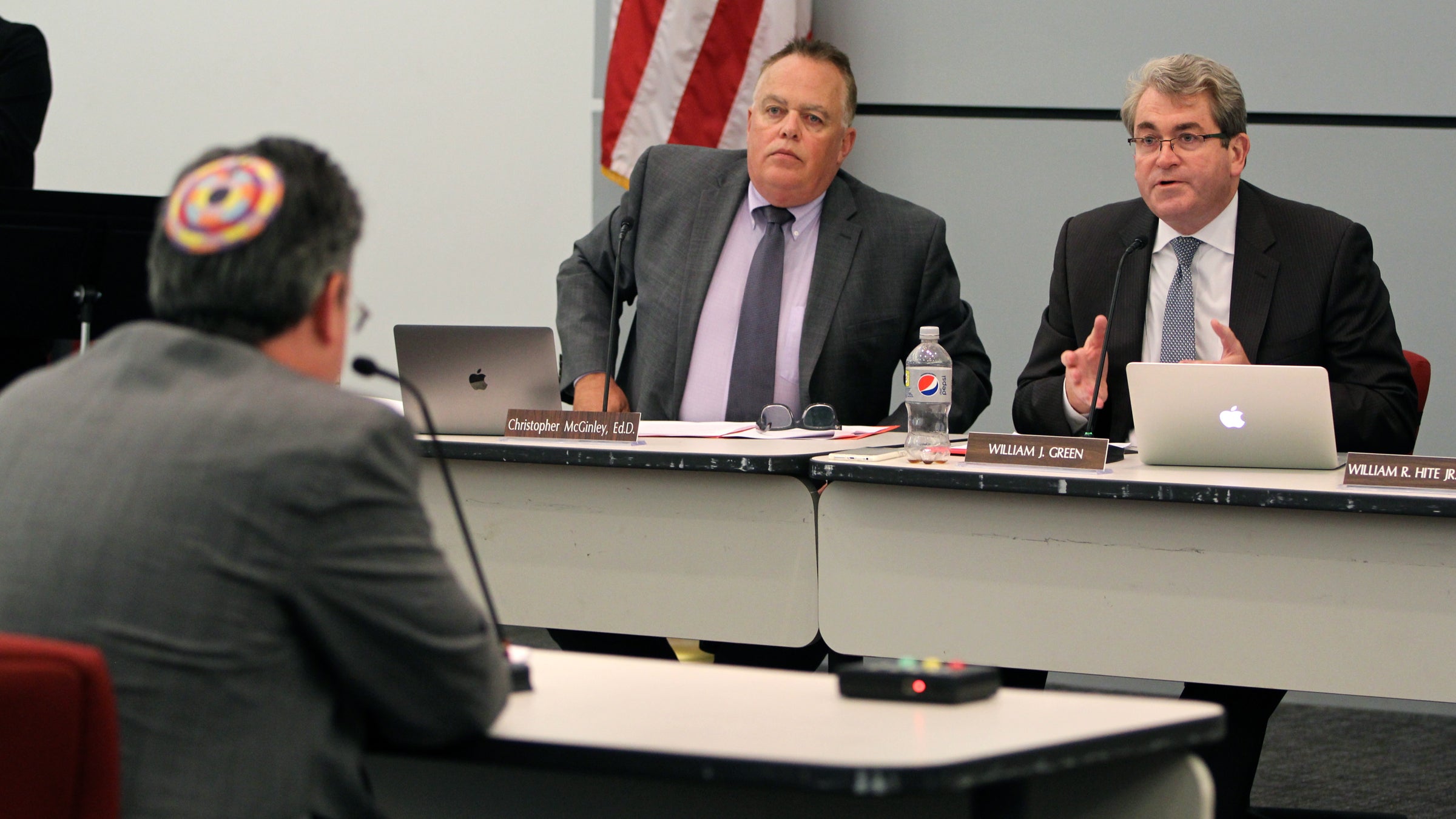It’s official: Philly teachers have a contract for the first time in four years
Listen
Philadelphia schools Chief Financial Officer Uri Monson (left) answers questions from School Reform Commission members about the district's new teachers contract. Commissioner Bill Green (right) cast the sole vote against the contract. (Emma Lee/WHYY)
The School Reform Commission approved the new contract with the Philadelphia Federation of teachers Tuesday amid warnings that a significant increase in city property taxes will be needed to pay for it.
The vote was 4-1.
Commissioner and former City Council member Bill Green was the sole “no” vote, calling the three-year pact “unaffordable and irresponsible.” District officials said it would cost $203 million over the three-year life of the contract and $395 million over five years — funds currently not in any budget projections.
SRC chair Joyce Wilkerson (who joined the meeting by phone) and members Farah Jimenez, Christopher McGinley and Estelle Richman voted in favor, although not without warnings of “challenges” ahead in finding the necessary funding.
Even so, the new deal marks a milestone for the district, which had been consumed with talk of teacher resignations and general unrest as the contract stalemate lengthened.
“My goal has been to reach a fair contract that recognizes and rewards teachers for their contributions, but does so in a way that appreciates the District’s financial limits,” said Superintendent William Hite. This agreement “accomplishes this goal.”
Hite repeatedly called the teacher’s contract his top priority, saying it was necessary to help the district retain talented staff.
“Our teachers have gone too long without a contract and this contract will provide stability for the School District moving forward,” said Hite. “Stability means we have teachers who are not looking to go elsewhere and staying to teach here.”
But can the district afford to keep them and give them more money?
Green pressed District Chief Financial Officer Uri Monson on whether the District had commitments from the state and city to help pay for the contract. The SRC, an appointed body, has no taxing power of its own, and agreeing to this contract requires new dollars that can only be generated with the support of state and local governments.
Monson responded that Mayor Kenney had made a commitment, but gave no details. There is no commitment from the state, he said. Without additional funds, a District shortfall now estimated at $700 million by 2022 would balloon to $979 million.
| FISCAL YEAR | PROJECTED DEFICIT (ACCORDING TO SRC TESTIMONY) |
| 2019 | $104 million |
| 2020 | $364 million |
| 2021 | $661 million |
| 2022 | $979 million |
“Is it a responsible budget?” Green asked Monson.
“It’s responsible in that it’s an accurate projection” of the costs, Monson responded. Green laughed.
Green warned that there will be as many as 800 layoffs by the September, 2018 school year and another 3500 layoffs in 2019 as the District seeks to bring its budget into line, causing families to flee the city.
“That’s going to result in instability, the very thing everyone says we’re trying to avoid,” Green said.
But McGinley countered that voting for the pact is “the most responsible action we can take today,” recognizing the sacrifices teachers that made during the four years without raises and setting the District on a path to stability.
“No school district or school board across this state has all the money on hand when they reach an agreement with a teachers’ union,” said McGinley, who has been superintendent in both Cheltenham and Lower Merion. “The district needs to have a stable and engaged workforce in order to realize the benefits of the deep investments that have been made in teacher training and support. We cannot have strong neighborhoods or commit to community schools without ensuring that we have a community of teachers who are committed to serve for the long-term.”
Richman, who has worked in the city, state, and federal governments, took a similar tack, saying she was “very comfortable” supporting the contract. In her experience, she said, “The first response to everything is that the money isn’t there.
“You don’t stop making good decisions, and this is a good decision, because all the money is not yet firmed up,” she said. “Everyone is fully aware of what this is and creates in terms of a deficit,” including Mayor Kenney, who pushed hard for the deal.
Farah Jimenez gave the contract her support, but warned that city property taxes could go up by 20 percent. Green had pegged the figure at 30 percent. Later, Monson said that if the city alone were to bear the entire burden of financing the pact, and do it through hiking the District’s portion of the property tax, the overall increase would be 16 percent.
But he noted that before the pact itself adds minimally to the need already there, explaining that to close the five-year shortfall without the new contract would require a 13 percent property tax hike.
The city’s property tax is split between the District and the city, 55 percent to 45 percent. Monson explained that if the rate on only the District’s portion went up by 30 percent with the city’s rate staying the same, that would even out to a 16 percent total increase to close the entire projected shortfall.
Just to plug the $203 million added to the financial hole by the new contract, the city would need to raise the school district’s slice of city tax revenue about 7 percent. Such a move would result in a roughly 4 percent hike in overall tax payments for each property owner.
The district has already readjusted its spending to account for money committed to the labor pact. Officials had promised to hire new teachers this school year to reduce the number of split classrooms and ease the need for leveling, a process where teachers are re-assigned in October to match actual school-by-school enrollment rather than projections. The district will no longer hire those additional teachers and instead redirect funds to paying for the increased salaries.
That alone will save $45 million over three years.
In approving the contract, the SRC has the “full and what I hope is not desperately naive” belief that local elected officials who sat in on negotiations and praised the agreement will sponsor legislation needed to “pay for the magnums of champagne we pop today,” Jimenez said. She added that the five-year outlook for the District has gone from “unsustainable” to “apocalyptic..
Asked again what kind of commitment Kenney made to find additional city funding, his spokeswoman Lauren Hill repeated that what he has committed to is “working with our various funding partners.”
Jane Roh, a spokesperson for City Council President Darrell Clarke, said Clarke “will continue to step up and work with state and city funding partners toward meaningful solutions to address the District’s deficit.
Roh also argued that the teachers’ contract, while significant, isn’t the primary cause of the district’s endemic money woes.
“Everyone who is familiar with and cares about public education in Philadelphia understands that the actual drivers of the District’s structural deficit are growing pension and charter costs and years of underfunding by the General Assembly —not educators’ salaries,” Roh said.
Councilwoman Helen Gym, a staunch PFT ally who was elected on the strength of her education activism and is a strong supporter of the contract, sounded a similar note. She said it is “far too premature to be throwing around numbers” about a property tax increase.
Funding the District, she said, “is a shared responsibility of which the city has put up more of its fair share and the state has not put up its fair and equitable share, even as it puts additional burdens on the school district, like passing an expanded pension bill and not funding it, and demanding we expand charters regardless of the quality of the charter application,” she said.
The district’s two fastest-growing expenses are charter and pension costs.
Gym also noted that there is a fair funding lawsuit pending seeking “fair and equitable” state education funding. Pennsylvania has the largest per pupil spending gap between rich and poor districts in the country, and one of the lowest state shares of total education spending, compared to local contributions.
But GOP leaders in Harrisburg don’t sound eager to ease the district’s financial strain.
“It will be hard to take any request from Philadelphia seriously given they do nothing to help themselves,” said Steve Miskin, spokesman for House Majority Leader Mike Turzai and the Republican caucus.
In remarks after the vote, Hite seemed weary but said he was pleased.
Hite also praised PFT president Jerry Jordan, saying that while the talks were “complicated and difficult,” they never became personal.
PFT members, also weary of the stalemate, ratified the pact Monday night by an unprecedented 19-to-1 margin, with 95 percent of those who turned out voting in favor, although most teachers interviewed said they did so reluctantly. While the contract includes some payments and increases that partially make up for compensation lost when they received no raises at all, some teachers — especially those with between four and eight years’ experience — will never recoup tens of thousands of dollars in wages they were due under the prior agreement.
Hite highlighted other aspects of the agreement as important:
— Full site selection of teachers in all schools.
— Teachers collaborating during their planning time
— Increased teacher work day for instruction to meet the statewide average by 2019. A study group will meet to work this out.
— Beginning kindergarten on the same day as other grades starting in 2018-19; now, kindergarten students start a week later.
— Teacher professional development in restorative practices, helping them to move away from punitive discipline measures.
Having PFT members contribute to their health care benefits for the first time will save $31.9 million over the three-year life of the contract; redesigning the medial plan saves $13.9 million and reduced contributions to the union’s Health and Welfare Fund saves $16.7 million.
“The Mayor knows that the District was facing a major fiscal issue even without this contract,” Hite said. “He told me that he’s committed to working with the City Council, the state and any other possible partners to develop a long-term and reliable funding solution that allows us to maintain investments and the progress in our schools.”
WHYY is your source for fact-based, in-depth journalism and information. As a nonprofit organization, we rely on financial support from readers like you. Please give today.





